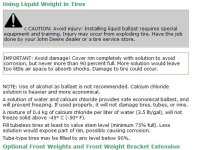There are alternatives to using fluid. As mentioned, you can put a ballast box on the rear and load it that way, or buy wheel weights. The ballast box is nice because you can take it off when you are not using your FEL, and therefore not dragging around weight you don't need.
The tires can do their job better without fluid in them as they are designed for air, not fluid.
Also, I would not put any fluid in the fronts. You already have enough weight up there, that is why you are weighting the rears.
If you are running radial tires, you will loose the flex you get from them when you put fluid in. With a larger contact patch, you get less soil compaction and more lug in the ground for traction. Fluid doesn't compress at the same rate as air, so you loose the benefits of the radial tire.
Bias tires are not as affected by this as they have very stiff sidewalls, and don't flex much anyway.
If you use the FEL all the time, then fluid will work fine. Just don't tube them and don't use Calcium. When you poke a thorn in a tubed tire, it is flat until you fix it. Tubeless, you might not ever know the thorn is in there.
Calcium is cheap, but corrosive and kills all vegetation it contacts.
Just use something, because it is pretty easy to lift the rear end off the ground and that is not a warm and fuzzy feeling. I know from experience. Gets the pucker factor going.
